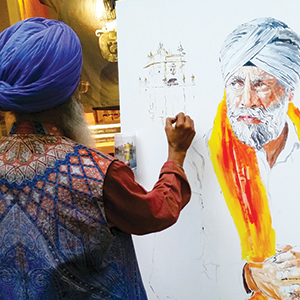

Ripple effects were felt worldwide, as the Sikh Foundation International—headquartered in Palo Alto—celebrated its 50th anniversary last weekend in grand-scale fashion. A few hundred Sikhs from around the globe dropped serious cash for a gala that took over the Asian Art Museum on Friday, followed by a free two-day conference at Stanford’s Li Ka Shing Center.
Somehow, surrounded by Sikhs, I managed to avoid talking about religion for the whole weekend and only one person tried to arrange a marriage for me.
But first of all, let me introduce Narinder Singh Kapany, more commonly known around the globe as Dr. Kapany, the father of fiber optics. Kapany started the Sikh Foundation exactly 50 years ago in 1967, and he’s been collecting Sikh art ever since. Over the decades, his collection has spawned several groundbreaking exhibits on several continents, including the current one at the Asian Art Museum. All of these exhibits have succeeded in foregrounding Sikh art in the contemporary museum-patron-collector nexus. On the academic front, Kapany has personally financed multiple endowments and chairs of Sikh studies at higher institutions across the country. If not for him, none of this would be happening.
Both the gala and the conference drew luminaries from a variety of backgrounds. At the conference, interfaith religious scholars, art collectors, medical technologists, and a beautifully esoteric old-school European strain of Indophile museum curator types all showed up and held court. It was fantastic.
For example, if I wanted to know which war-era descendant of which Punjabi maharajah sold a $60,000-dollar book of original Sikh-illustrated drawings of the high court to a strange collector in France, someone in the room probably had the answer. Art ruled the weekend.
The festivities also celebrated the official release of a brand new volume, Sikh Art From the Kapany Collection, a gargantuan 320-page hardcover art book including numerous scholarly texts by internationally recognized art historians analyzing Kapany’s collection. Edited by Paul Michael Taylor, of the Smithsonian Institution’s Asian Cultural History Program, and Sikh Foundation Executive Director Sonia Dhami, the book includes three main sections. The first section concentrates on the collectors and their vision, with biographical and profile information about the Kapanys and their history. The second section surveys the collection in terms of how it conveys Sikh history and ethos. The third and final section deals with stamps, coins and textiles from Kapany’s collection, while also offering still more contemporary perspectives on how to preserve and exhibit the collection.
Several of the authors included in Sikh Art gave presentations at the Stanford conference, which unfolded over two days. The Saturday afternoon session was titled, “Sikh Arts and Heritage—Expanding Horizons,” and it featured a star-studded lineup. I felt like a teenager at a rock show, in that I didn’t want to leave until the last person was gone.
One of India’s most distinguished contemporary painters, Arpana Caur, presented a gorgeous PowerPoint slideshow of 40 years’ worth of her work, some of which featured brutal depictions of the horrors suffered during the 1947 Partition of India, albeit in abstract representations.
Author Bhupinder Singh Bance, also known as Peter Bance, came from England to present on the strange life of the last Sikh maharajah, Duleep Singh, a character who ascended to the throne in Punjab at age 5 and remained there for eight years until the British conquered Punjab and forced him into exile by bringing him back to the United Kingdom and converting him to Christianity. Once in England, Duleep became an exotic party accessory in Queen Victoria’s crowd before eventually reclaiming his Sikh faith and trying to return to Punjab. To make a long story short, he wound up dying in a Paris hotel room.
Other speakers rounding out the Arts and Heritage afternoon included Dr. Jean-Marie Lafont of France, an author of many books over the last 40 years, mostly about Franco-Punjabi relations and Indo-French connections during the Sikh empire. Lafont gave a presentation about the 19th century Punjabi artist Imam Bakhsh and his illustrations for La Fontaine’s Fables.
Among such scholarly giants of Punjab history and arts, I was blown away. Here’s to another 50 years!



